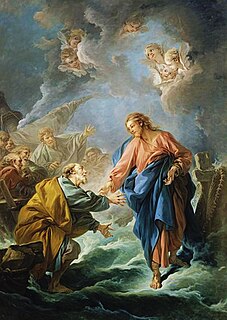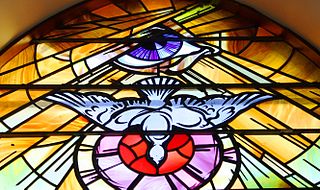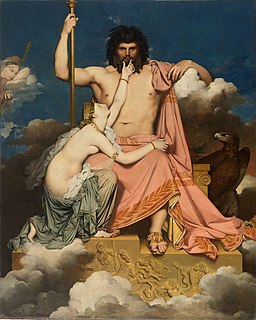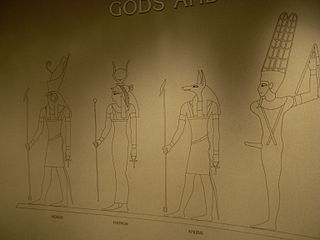Related Research Articles
Monotheism is the belief in one god. A narrower definition of monotheism is the belief in the existence of only one god that created the world, is omnipotent, omnipresent and omniscient.
A creator deity or creator god is a deity or god responsible for the creation of the Earth, world, and universe in human religion and mythology. In monotheism, the single God is often also the creator. A number of monolatristic traditions separate a secondary creator from a primary transcendent being, identified as a primary creator.

The supernatural encompasses supposed phenomena that aren't subject to the laws of nature. By definition, a supernatural manifestation or event requires a violation of physical law believed to have been attributed to non-physical entities, such as angels, demons, gods, poltergeists, etc. It also includes claimed abilities embodied in or provided by such beings, including magic, telekinesis, levitation, precognition, and extrasensory perception. The philosophy of naturalism contends that all phenomena are scientifically explicable and nothing exists beyond the natural world, and as such approaches supernatural claims with skepticism.
Dinka mythology refers to the traditional religion and folk tales of the Dinka, or Muonyjang, ethnic group of South Sudan.

Omnipresence or ubiquity is the property of being present anywhere and everywhere. The term omnipresence is most often used in a religious context as an attribute of a deity or supreme being, while the term ubiquity is generally used to describe something "existing or being everywhere at the same time, constantly encountered, widespread, common". Ubiquitous can also be used as a synonym for words like worldwide, universal, global, pervasive, all over the place. Being Omnipresent relates to the fact of having the presence of God everywhere.

Theophany is the manifestation of a deity in an observable way.

The Nuer people are a Nilotic ethnic group concentrated in the Greater Upper Nile region of South Sudan. They also live as a refugees in the Ethiopian region of Gambella. The Nuer speak the Nuer language, which belongs to the Nilotic language family. They are the second largest ethnic group in South Sudan. The Nuer people are pastoralists who herd cattle for a living. Their cattle serve as companions and define their lifestyle. The Nuer call themselves "Naath".
Ancient Semitic religion encompasses the polytheistic religions of the Semitic peoples from the ancient Near East and Northeast Africa. Since the term Semitic itself represents a rough category when referring to cultures, as opposed to languages, the definitive bounds of the term "ancient Semitic religion" are only approximate.
Conceptions of God in monotheist, pantheist, and panentheist religions – or of the supreme deity in henotheistic religions – can extend to various levels of abstraction:

The sky often has important religious significance. Many religions, both polytheistic and monotheistic, have deities associated with the sky.
A kamuy is a spiritual or divine being in Ainu mythology, a term denoting a supernatural entity composed of or possessing spiritual energy.
Deng, also known as Denka, is a sky, rain, and fertility god in Dinka mythology for the Dinka people of Sudan and South Sudan. He is the son of the goddess Abuk.

Polytheism is the worship of or belief in multiple deities, which are usually assembled into a pantheon of gods and goddesses, along with their own religions and rituals. In most religions which accept polytheism, the different gods and goddesses are representations of forces of nature or ancestral principles, and can be viewed either as autonomous or as aspects or emanations of a creator deity or transcendental absolute principle, which manifests immanently in nature.

A deity or god is a supernatural being considered divine or sacred. The Oxford Dictionary of English defines deity as "a god or goddess ", or anything revered as divine. C. Scott Littleton defines a deity as "a being with powers greater than those of ordinary humans, but who interacts with humans, positively or negatively, in ways that carry humans to new levels of consciousness, beyond the grounded preoccupations of ordinary life".

Chinese traditional religion is polytheistic; many deities are worshipped in a pantheistic view where divinity is inherent in the world. The gods are energies or principles revealing, imitating and propagating the way of Heaven, which is the supreme godhead manifesting in the northern culmen of the starry vault of the skies and its order. Many gods are ancestors or men who became deities for their heavenly achievements; most gods are also identified with stars and constellations. Ancestors are regarded as the equivalent of Heaven within human society, and therefore as the means connecting back to Heaven, which is the "utmost ancestral father".

The Wǔfāng Shàngdì, or simply Wǔdì or Wǔshén are, in Chinese canonical texts and common Chinese religion, the fivefold manifestation of the supreme God of Heaven. This theology harkens back at least to the Shang dynasty. Described as the "five changeable faces of Heaven", they represent Heaven's cosmic activity which shapes worlds as tán 壇, "altars", imitating its order which is visible in the starry vault, the north celestial pole and its spinning constellations. The Five Deities themselves represent these constellations. In accordance with the Three Powers they have a celestial, a terrestrial and a chthonic form. The Han Chinese identify themselves as the descendants of the Red and Yellow Deities.
Slavic Native Faith (Rodnovery) has a theology that is generally monistic, consisting in the vision of an absolute, supreme God (Rod) who begets the universe and lives as the universe, present in all its phenomena. Polytheism, that is the worship of the gods or spirits, and ancestors, the facets of the supreme Rod generating all phenomena, is an integral part of Rodnovers' beliefs and practices.
Ngewo is the supreme creator god of the people of Mende from Sierra Leone.
Nzame is the supreme creator god featured in the mythologies of the Fang people of Equatorial Guinea, Gabon, and Cameroon. The name is used to refer to a trinity of deities, which included Nzame, Mebere and Nkwa and is also used in reference to Nzame, one of the members of this trinity.
References
- 1 2 3 4 Lynch, Patricia Ann; Roberts, Jeremy (2010). African Mythology, A to Z. Infobase Publishing. ISBN 978-1-4381-3133-7.
- 1 2 3 4 5 "Kwoth and the Cutting of the Link between Heaven and Earth". Oxford Reference. Retrieved 2021-02-15.
- 1 2 Thomas, Douglas; Alanamu, Temilola (2018-12-01). African Religions: Beliefs and Practices through History. ABC-CLIO. ISBN 978-1-61069-752-1.
- 1 2 "Monotheism - The spectrum of views: monotheisms and quasi-monotheisms". Encyclopedia Britannica. Retrieved 2021-02-15.